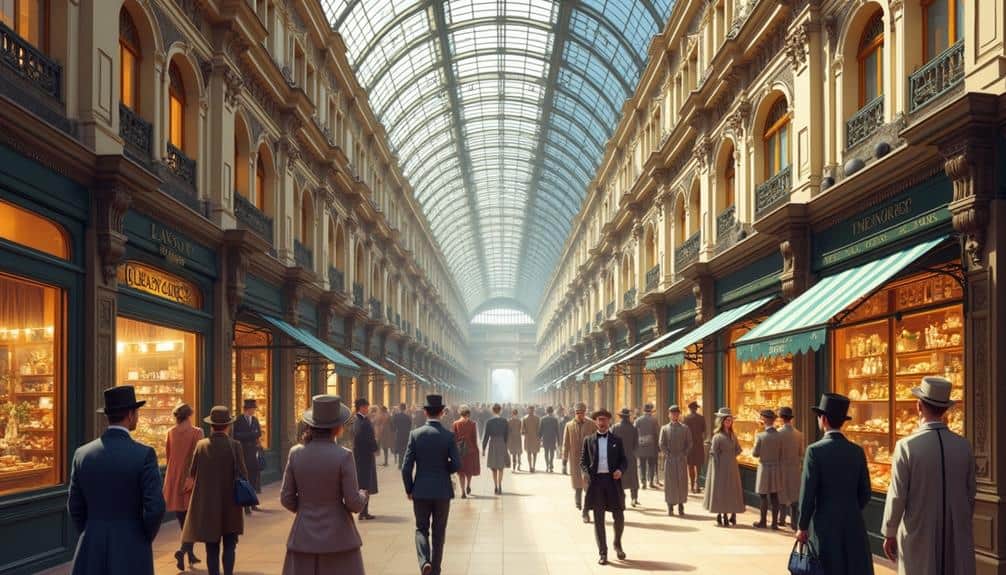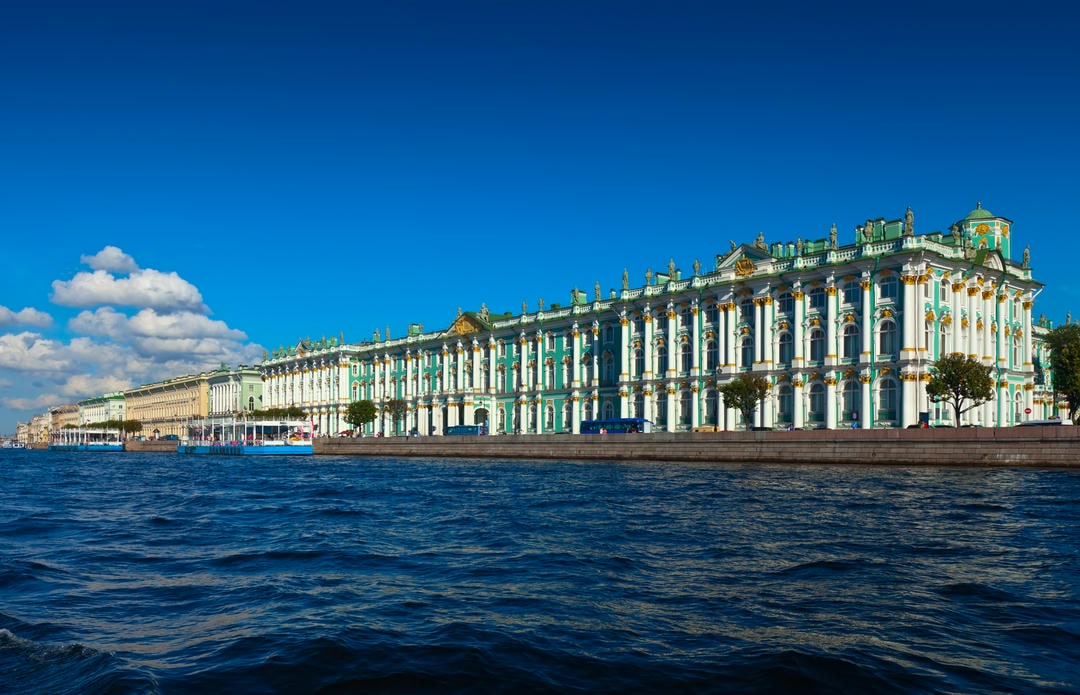The history of Russia’s GUM Mall is a reflection of its enduring cultural and architectural significance, from its inception in the mid-19th century through its evolution into a modern-day luxury hub. Initially designed by the esteemed Joseph Bové, GUM’s neoclassical grandeur mirrored the opulence of the Tsarist era. However, the mall’s narrative took a dramatic turn during the Soviet period, where it shifted focus to functionality and mass accessibility. This transformation continued through wartime and into the post-war period, each phase reflecting broader societal shifts.
Origins and Early Years

Although the grandeur of GUM Mall is widely recognized today, its origins trace back to the mid-19th century when the concept of a large-scale trading center in Russia was first envisioned. The initial impetus for GUM’s development emerged from a pressing need to centralize Moscow’s fragmented retail landscape.
The early architectural influences were rooted in European practices, particularly those observed in Parisian arcades and London’s markets. The retail evolution during this period saw a shift from small, scattered shops to more centralized and organized trading spaces. This transformation was driven by growing urban populations and the increasing complexity of commercial activities.
The design of the original GUM, conceived by the architect Joseph Bové, was a pioneering feat. It incorporated a synthesis of neoclassical and Russian revival styles, reflecting both Western influences and local architectural traditions.
GUM’s early years were marked by a series of expansions and renovations, aimed at accommodating the burgeoning demands of a modern retail environment. As a result, it became a prototype for subsequent commercial structures in Russia.
This early stage laid the foundational framework for GUM’s evolution into a premier retail destination, embodying both historical and contemporary commercial aspirations.

Tsarist Era Grandeur
The early architectural advancements and organizational innovations of GUM set the stage for a period of opulence during the Tsarist era. This era was marked by the mall’s embodiment of imperial architecture, reflecting the grandeur of Russia’s autocratic elite.
Constructed between 1890 and 1893, GUM’s design was the brainchild of architect Alexander Pomerantsev and engineer Vladimir Shukhov, who implemented a harmonious blend of traditional Russian motifs and innovative engineering techniques. The result was a monumental structure featuring a series of interconnected arcades with a glass roof, a marvel of modern construction at the time.
This architectural splendor was complemented by the mall’s role as a center of luxury shopping. GUM housed over a thousand stores, offering a wide array of high-end goods, from fine jewelry and elegant clothing to imported delicacies.
The mall’s interior was designed to provide an opulent shopping experience, with marble floors, elaborate ironwork, and ornate decorations enhancing its aesthetic appeal. For the Russian aristocracy and burgeoning bourgeoisie, GUM became not only a marketplace but also a social hub, embodying the luxurious lifestyle and cultural aspirations of the Tsarist era.
The Soviet Transformation
GUM Mall’s transformation during the Soviet era marked a significant shift from its Tsarist grandeur to a symbol of socialist ideals and utilitarianism. Under the new regime, the mall was repurposed to reflect the ethos of Soviet architecture, which emphasized functionality and collective utility over opulence.
The expansive glass-roofed arcade, which originally catered to the elite, was reimagined to serve the proletariat, mirroring the broader societal changes of the time. The Soviet government saw GUM as a tool to promote its consumer culture, aiming to demonstrate the availability and quality of goods produced under socialism.
It became a showcase for domestic products, from clothing and household items to foodstuffs, aligning with the state’s objective of self-sufficiency. This transformation was not just physical but ideological, as GUM’s role evolved to support propaganda efforts, reinforcing the narrative of socialism’s superiority in meeting the needs of the masses.
Architecturally, while the mall retained its iconic façade, interior renovations were undertaken to optimize space usage for increased functionality. This period illustrated a blend of preserving historical structures while embedding them with new social and economic purposes, marking a distinctive era in GUM’s storied history.
GUM During World War II
During World War II, GUM faced unprecedented challenges that tested its resilience and adaptability. As the conflict engulfed the Soviet Union, the renowned shopping complex on Red Square was repurposed to support the war effort. The introduction of strict rationing policies fundamentally altered the nature of commerce within GUM. Essential goods, including foodstuffs and textiles, were distributed according to state-imposed quotas, limiting the availability of consumer luxuries that had previously characterized the mall’s offerings.
The transformation of GUM into a logistical hub underscored its wartime resilience. Despite the severe constraints, the mall maintained operations, albeit in a drastically different capacity. It served as a distribution center for ration coupons and essential supplies, ensuring that the civilian population had access to necessary resources. This shift highlighted GUM’s ability to adapt to the exigencies of war, prioritizing functionality over commercialism.
Additionally, the architectural integrity of GUM was preserved, despite the city’s vulnerability to air raids. Protective measures were implemented to shield the building from potential damage, reflecting the strategic importance of the structure. Consequently, GUM not only survived the war but also emerged as a symbol of Soviet endurance and communal solidarity amidst adversity.
Post-War Revival
Following the end of World War II, GUM faced the monumental task of shifting from a wartime logistical hub back to its pre-war status as a premier shopping destination. The change was not merely a commercial endeavor but also a significant architectural and economic undertaking, reflective of the broader post-war recovery efforts across the Soviet Union.
Post-war architecture played an essential role in this transformation. The Soviet government prioritized the restoration and modernization of GUM, recognizing its symbolic importance in demonstrating the resilience and resurgence of the nation. The mall’s intricate façade, originally designed by architect Alexander Pomerantsev, was meticulously restored to its former grandeur.
Simultaneously, the interior spaces were reimagined to accommodate the evolving consumer needs of the post-war era, incorporating more efficient layouts and improved amenities.
Economic recovery strategies were equally pivotal. GUM’s revival aligned with broader Soviet policies aimed at revitalizing urban centers and stimulating domestic consumption. As the economy gradually stabilized, GUM re-emerged as a bustling commercial hub, stocked with a diverse array of goods, from everyday necessities to luxury items.
This revival was emblematic of the broader economic recovery, demonstrating the resilience and adaptability of Soviet commerce in the post-war context.
Modern-Day GUM
As the 21st century unfolds, GUM stands not just as a tribute to historical resilience but as a vibrant symbol of modern Russian commerce and culture.
Situated in the heart of Moscow, GUM has transformed into a premier destination for luxury shopping, seamlessly blending its storied past with contemporary opulence. High-end brands such as Louis Vuitton, Gucci, and Prada now grace its halls, attracting affluent shoppers and international tourists alike.
Beyond its commercial significance, GUM serves as a cultural landmark, hosting art exhibitions, seasonal events, and public gatherings.
Its architectural grandeur, characterized by the iconic glass roof and intricate ironwork, remains a demonstration of its historic roots while providing a stunning backdrop for modern-day festivities. The mall’s strategic location adjacent to Red Square further enhances its status as a must-visit site.
GUM’s adaptation to modern retail trends, including the integration of digital technologies and personalized shopping experiences, underscores its commitment to staying relevant in an ever-evolving market.
Consequently, GUM not only preserves its rich heritage but also embodies the dynamic spirit of contemporary Russian society, making it an enduring emblem of both tradition and innovation.
GUM Mall’s evolution from a luxurious Tsarist-era establishment to a utilitarian Soviet space, and ultimately to a modern symbol of Moscow’s blend of tradition and contemporary culture, underscores its adaptability to fluctuating socio-political climates. The architectural heritage, marked by Joseph Bové’s neoclassical design, has been preserved and integrated into its current role as a premier shopping destination. GUM Mall not only reflects Russia’s historical transformations but also its enduring capacity to merge past and present.





